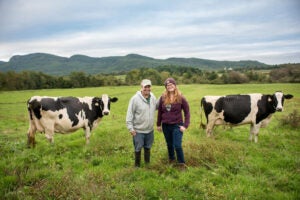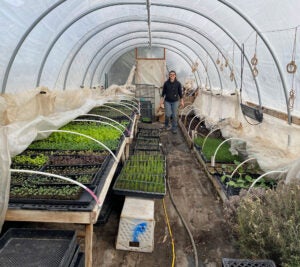The current farm bill expires at the end of September, which means the future of our nation’s food system is at a critical crossroads. Congress is currently writing the next farm bill which will shape our nation’s farm and food policy for the next five years.
American Farmland Trust has spent years listening to farmers and ranchers and developing policies for this moment — policy priorities that will protect farmland, help farmers on the front lines of climate change, and expand opportunities for a diverse new generation of producers. Everyone has a stake in building a resilient farm and food system. And as Congress enters challenging negotiations and makes difficult trade-offs, now is the best time to take action to help us create a farm bill for the future.
The largest barrier that anyone entering agriculture faces is accessing affordable farmland, and this barrier has gotten even greater in recent years. Since 2019, the average cost of farmland nationally has gone up nearly 30 percent. In some parts of the country, this jump has been even higher. For instance, land values in the Northern Plains shot up 46 percent.

With agricultural land at record prices — and steep competition from investors, established farmers, as well as solar and real estate developers — many young, beginning, and historically marginalized producers struggle to access land. At the same time, many senior farmers and farmland owners have no one to take over their operation.
With the current generation of farmers nearing retirement, our food system depends upon a new generation taking the reins.
A new bipartisan, bicameral bill would tackle this challenge head on. The Land Access, Security, and Opportunities Act would permanently establish and fund the first-ever USDA program specifically dedicated to supporting land access. If included in the farm bill, the legislation would expand funding for community-based projects to help young, beginning, and BIPOC producers access land, capital, and markets, with services including succession planning, down payment support, business and financial planning, and heirs’ property issues. Congress should couple the authorization of this new program with changes to the Agricultural Conservation Easement Program to enable more land trusts to buy land, place it under permanent protection, and target its sale (so-called “Buy-Protect-Sell” projects) to new producers to create even more opportunities for land access.
But accessing farmland is just one challenge farmers face. Extreme weather, inflation, supply chain disruptions, and other uncertainties make an already risky business even more uncertain, particularly for small-scale producers. As the pandemic so starkly illustrated, these farms are essential to local and regional food access and are critical to our rural economies, food security, and community resilience. Small acreage farms — those with fewer than 180 acres — represent 70 percent of all farms in the U.S.

But despite their importance to our rural communities, small-acreage farms face unique challenges and many struggle to access USDA programs that are often designed with a one-size-fits-all approach. For instance, farm relief programs have not always taken into account the prices that these small farms may receive for selling local or producing value-added or organic products. Such farms also do not have the benefit of distributing costs or losses over many acres. It’s clear that small-scale producers need a new approach. The bicameral Office of Small Farms Establishment Act would help level the playing field by creating a new office at the USDA tasked with ensuring that these farms can access the full suite of essential USDA programs, services, and support. Such a step in the next farm bill could be transformational.
Finally, more must be done to support producers in building their resilience to a changing climate. Conservation practices like cover crops, reduced tillage, and rotational grazing can help farmers mitigate the impacts of extreme weather events and are critical to building the soil and maintaining profitability, to say nothing about the improved water quality and carbon sequestration they also provide to society as a whole.
While the USDA plays an essential role in providing financial and technical support for producers in adopting these practices, this support leaves gaps and doesn’t always result in the continuation of practices beyond the contract period. There is no better or more trusted voice in supporting successful, long-term adoption of new conservation practices than that of other farmers. The bipartisan Farmer to Farmer Education Act would enable more farmers to benefit from the experience, innovation, and leadership of other producers by strengthening existing farmer-led education networks and building capacity for new ones.
Such networks are especially important to reaching and serving historically marginalized communities, some of which are hesitant to work directly with the federal government given past experiences. Ensuring that farmers can support other farmers is all the more critical as the USDA continues to award increased conservation funding from the Inflation Reduction Act.
Each of these pieces of legislation can expand opportunities in agriculture and help support a new, diverse generation of farmers and ranchers. As Congress writes a new farm bill in a challenging political and budgetary environment, every voice can be the critical difference between whether these important policies are included or are left on the cutting room floor.
Now is the time to make your voice heard!




